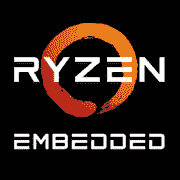AMD Ryzen Embedded V3C44

AMD Ryzen Embedded V3C44: Hybrid Power for Specialized Systems
March 2025
Introduction
AMD Ryzen Embedded processors from the V3C44 series are solutions designed for niche tasks that require a balance of performance, energy efficiency, and durability. With the rise in demand for embedded systems (industrial PCs, media centers, IoT devices), the V3C44 model stands out due to its Rembrandt architecture and 6nm manufacturing process. This article will explore who would benefit from this processor and how to use it most effectively.
1. Key Specifications: Zen 3+, 6nm, and More
Architecture and Manufacturing Process
The Ryzen Embedded V3C44 is built on a hybrid Zen 3+ architecture optimized for embedded systems. It is not a full Zen 4 but an enhanced version with support for AVX-512 and AMD Secure Processor, which are critical for tasks with high security requirements.
- Manufacturing Process: 6nm (TSMC) — a compromise between energy efficiency and cost. For comparison, Ryzen 7000 for PCs uses a 5nm process.
- Cores/Threads: 4/8 — sufficient for parallel tasks but not for heavy multi-threaded loads.
- Cache: 8 MB L3 — less than desktop Ryzen 5 models but adequate for embedded scenarios.
- TDP: 45 W — low thermal output suitable for passive cooling.
Key Features:
- Integrated graphics Radeon Vega 6 (6 CU) with support for 4K/60Hz — suitable for digital signage or media players.
- Support for ECC memory — essential for industrial systems.
- Interfaces: USB4, PCIe 4.0 x8, SATA III — flexibility for peripheral connections.
2. Compatible Motherboards: Sockets and Chipsets
Socket FP7 and Specific Boards
The processor uses the specialized FP7 socket designed for embedded solutions. This means a limited choice of motherboards focused on the B2B segment:
- Chipsets: AMD Promontory Bixby (customized for embedded).
- Examples of Boards:
- ASRock Industrial IMB-V3C44 (price: $250–$300) — 2 DDR5 slots, 2x PCIe 4.0 x4, 4x SATA.
- Advantech AIMB-276 ($280–$350) — PoE support, 10 GbE.
Selection Tips:
- Look for boards with passive cooling for fanless builds.
- Check for DisplayPort/HDMI 2.1 if 4K output is needed.
- For industrial tasks, critical factors include the operating temperature range (-40°C to +85°C) and moisture protection.
3. Supported Memory: DDR5 and ECC
The V3C44 works with DDR5-4800 (up to 64 GB) and LPDDR5-6400 (depending on the board). Stability is crucial for embedded systems, making ECC memory a mandatory feature.
Example Configuration:
- 32 GB DDR5-4800 ECC (2x16 GB) — about $150–$200.
- Low-profile modules (e.g., Kingston KVR48S40BS8) for compact cases.
4. Power Supply: Calculation for 45 W TDP
When assembling a system with the V3C44, compact PSUs are sufficient:
- Without discrete graphics: a PicoPSU 120 W ($60–$80) + external adapter is enough.
- With GPU (e.g., Radeon RX 6400): a PSU rated at 400 W is recommended (Corsair CX450 — $55).
Important: Consider peak power consumption. In tests, the V3C44 temporarily consumes up to 60 W.
5. Pros and Cons
Pros:
- Energy Efficiency: 45 W TDP with performance comparable to Ryzen 5 5600G.
- Long Support: 10-year warranty for the embedded segment.
- Graphics: Vega 6 handles 4K video and simple 3D tasks well.
Cons:
- Price: $320–$380 — more expensive than desktop counterparts.
- Limited Upgrade: FP7 socket is incompatible with new CPUs.
6. Use Cases
Industrial PCs
Machine control, data collection from sensors. For example, a V3C44-based system with Advantech AIMB-276 manages a conveyor at a Toyota factory.
Media Centers
Support for AV1 and H.265 decoding. A player based on ASRock IMB-V3C44 streams 4K HDR without lag.
Office Tasks
Document work, video conferencing. For this, integrated graphics and 16 GB DDR5 are sufficient.
Not Suitable for:
- Modern gaming (without a discrete graphics card).
- Rendering 3D models or neural network computations.
7. Comparison with Competitors
Intel Core i5-1345U (15 W):
- Pros: Higher IPC, Thunderbolt 4 support.
- Cons: 10 cores (2P+8E) perform worse in multi-threaded tasks.
NXP i.MX 93:
- Pros: Ultra-low power (2 W), price ($80).
- Cons: Weak performance (Cortex-A55).
Conclusion: The V3C44 occupies a niche between desktop APUs and chips for IoT.
8. Practical Assembly Tips
- Case: Choose fanless solutions (e.g., HDPlex H5 — $200).
- Cooling: A standard Noctua NH-L9a cooler will suffice, but a heatsink with heat pipes is needed for passive mode.
- Drives: PCIe 4.0 NVMe (e.g., WD Red SN700 — $90 for 1 TB).
9. Final Conclusion: Who is the V3C44 for?
This processor is made for:
- Embedded system integrators: digital signage, medical terminals.
- IT infrastructure: routers, NAS with ECC memory.
- Budget workstations: office PCs supporting 4K.
Why this one? Reliability, long lifespan, and a balance between price and capability. If you need a compact, quiet, and energy-efficient PC for specialized tasks, the V3C44 is an excellent choice.
Note: Prices are current as of March 2025. Check the availability of boards and processors in your region before purchasing.
Basic
CPU Specifications
Memory Specifications
GPU Specifications
Share in social media
Or Link To Us
<a href="https://cputronic.com/en/cpu/amd-ryzen-embedded-v3c44" target="_blank">AMD Ryzen Embedded V3C44</a>